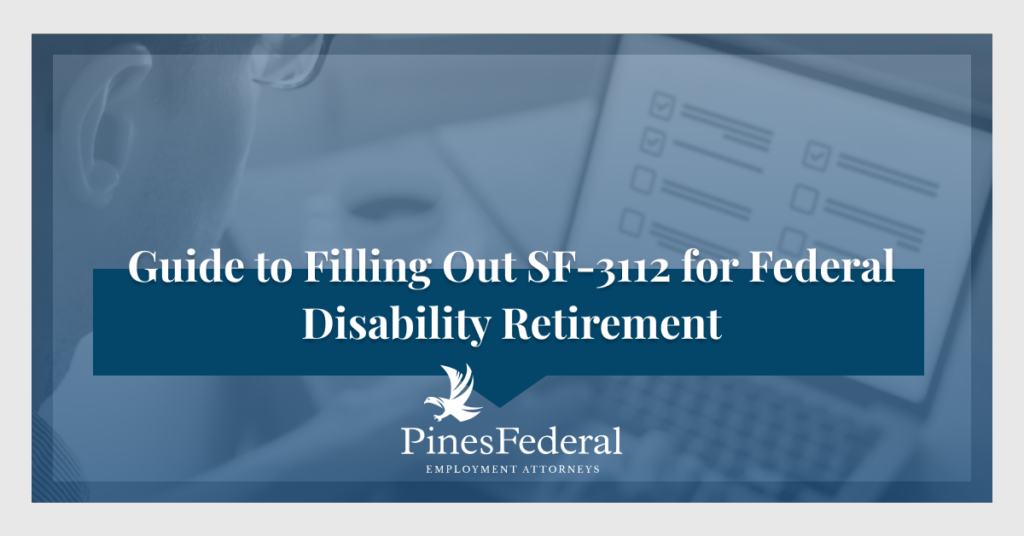
Standard Form 3112 is the most vital document for federal employees seeking federal disability retirement.
We cannot emphasize strongly enough how important it is to fill out an SF-3112 form correctly.
Even simple mistakes can delay or upend your disability retirement application.
Fortunately, we’ve written this guide to help walk you through each part of this form. We’ll discuss the parts of the SF-3112, the importance of each part, and how to fill it out accurately.
For a consultation with our experienced lawyers, please contact us online or call (800) 801-0598 today.
Detailed Overview of SF-3112
Form SF-3112, formally known as the “Application for Immediate Retirement,” is a foundational document for federal employees seeking disability retirement benefits.
This form acts as the vehicle through which you communicate to the Office of Personnel Management (OPM) your need for disability retirement. It applies to employees working under both the Federal Employees Retirement System (FERS) and the Civil Service Retirement System (CSRS).
Given its significance, filling out your SF-3112 requires a meticulous approach. The SF-3112 is not just another federal form that you can rush through. Nor is it a form where you merely focus on filling in the blanks in the document.
Instead, it is your most important opportunity to present a compelling case that clearly communicates your disability, its impact on your work, and your eligibility for disability retirement.
The SF-3112 form is divided into several sections, each designed to gather specific information regarding your disability, employment history, your employer’s accommodation efforts, and medical attestations concerning your disability.
These sections include SF-3112A (Applicant’s Statement of Disability), SF-3112B (Supervisor’s Statement), SF-3112C (Physician’s Statement), SF-3112D (Agency Certification of Reassignment and Accommodation Efforts), and SF-3112E (Disability Retirement Application Checklist). Each section serves a unique function and is integral to your application.
Filling Out the SF-3112: A Section-by-Section Guide
Filling out an SF-3112 can seem like an overwhelming task due to its detailed and multifaceted nature. Let’s break down each section one at a time.
SF-3112A: Applicant’s Statement of Disability
This is the section where you, as the applicant, detail your disability and its impact on your ability to fulfill your job duties.
It serves as the crux of your application, giving evaluators an in-depth look into your personal and professional struggles. Clarity and detail are vital here.
Use clear language to explain your medical condition, symptoms, and how they impair your work performance. Avoid veering into overly technical medical jargon, and instead, present your situation in relatable terms.
Include all conditions that contribute to your disability. Consider each condition’s frequency, duration, and severity to offer a full scope of its effects. Then link these conditions to your inability to perform your job. Make it evident if, for instance, a particular symptom hinders you from performing a specific task essential to your role.
This section also requires you to list your job history for the last five years. Consequently, ensure the information you provide is accurate and up-to-date. Cross-check the information you provide with official employment records to prevent any inconsistencies.
An up-to-date employment history lends credibility to your application and helps officials gauge the extent of your disability in the context of your recent roles. On the other hand, even minor discrepancies can raise doubts or lead to unnecessary delays in your application process.
SF-3112B: Supervisor’s Statement

Your immediate supervisor is responsible for completing this section. It should contain a comprehensive account of your job performance, including your attendance, behavior, and any disciplinary issues.
The objective is to offer a holistic view of your professional conduct and capability, spotlighting areas where your disability may have made a noticeable impact.
Section B should also capture any reasonable accommodation attempts made by your employer. This includes modifications to work hours, special equipment provided, and alterations to your workspace or tasks.
It’s essential your supervisor provides a comprehensive picture of how your disability affects your job performance. Work closely with your supervisor during the completion of this section to ensure the information presented aligns with your claim.
Open dialogue is paramount. Establish regular check-ins, and consider drafting a preliminary document together. This collaboration can mitigate any discrepancies and foster a unified presentation of facts.
Furthermore, while the completion of SF-3112B primarily lies with your supervisor, it’s beneficial for you to familiarize yourself with the form’s particulars. This knowledge can help guide conversations and ensure no essential detail is overlooked.
It’s also advisable to retain a copy for your records once completed. Should any disputes arise in the future, having your supervisor’s statement on hand can be invaluable.
SF-3112C: Physician’s Statement
The next section must be completed by your physician.
It should detail your:
- Diagnosis,
- Symptoms, and
- Prognosis (likelihood and timeline of recovery).
Additionally, it would be beneficial to include any treatments, medications, or therapies you’re currently undergoing or have undergone in the past.
It should also discuss the specific ways in which your medical condition impacts your ability to perform your duties, acting as a vital cornerstone to substantiate your need for accommodation or support.
This section provides medical validation for your claim. Therefore, your physician should fill it out thoroughly and accurately. It’s crucial to remember that while medical terms are inevitable in this section, they should be presented in a way that’s easy for non-medical personnel to understand.
With our clients, we actually draft up a doctor’s letter for the doctors to use and fill out on their own. This makes it easier to capture their point of view and communicate it smoothly to non-medical individuals. As with section B, it’s advisable to review this section with your doctor to ensure it matches your application’s details.
A collaborative approach, especially with your doctor and legal counsel, can help highlight any missing links or areas that require more clarity.
Given the significance of the Physician’s Statement, it’s essential to allocate enough time for its completion. Schedule an appointment with your physician dedicated solely to addressing your SF-3112C. This focused interaction ensures that the doctor clearly understands the form’s requirements and can detail your condition without being rushed.
Giving your physician a brief overview or summary of your job responsibilities is also wise. By properly summarizing your duties, you can guide your doctor in articulating precisely how your medical condition could inhibit or modify your job performance.
SF-3112D: Agency Certification of Reassignment and Accommodation Efforts
The next section focuses on your agency’s attempts to accommodate your disability. It’s a testament to the agency’s commitment to fostering an inclusive workplace environment.
It must discuss what your agency has done to accommodate your disability or reassign you to a suitable position. Make sure you include specific instances, dates, and any measures that they implemented.
This section documents whether the agency made reasonable efforts to retain you despite your disability. It serves as a pivotal record, outlining if and how the agency has adhered to disability laws and regulations in its handling of your situation.
Your agency’s human resources department is responsible for completing this part of the SF-3112. Because of bureaucratic pitfalls, it’s especially important to check this section for accuracy and completeness.
Remember, inconsistencies or ambiguities here could jeopardize the legitimacy of your application or lead to unnecessary delays in processing.
In light of the importance of SF-3112D, fostering open communication with your human resources department is key. Engage in regular discussions, perhaps even establishing a timeline for the section’s completion. By being proactive, you can ensure that the department understands the gravity of your situation and prioritizes your application.
Moreover, keeping copies of all communications and internal memos related to your accommodation or reassignment can be invaluable. Presenting these documents can support the content of this section, showcasing a transparent trail of the agency’s efforts and decisions.
SF-3112E: Disability Retirement Application Checklist
The final section of the SF-3112 is essentially a self-audit tool to help you confirm that your application is complete. It consists of a list of statements that you need to check off after checking they are true.
It also serves as a final confirmation that all necessary sections have been filled out and all required documents are attached before submission. Think of it as your last line of defense against potential oversights.
Remember, each section of SF-3112 carries significant weight and should be filled out with due care and diligence. It’s your chance to make a compelling case for your need and eligibility for disability retirement benefits.
Your application is an argument for why you qualify for disability retirement benefits, and each part contributes to that argument. Each section, including this checklist, interweaves to form a comprehensive story: your story. As such, it’s vital to ensure that the narrative is compelling, accurate, and free of contradictions.
As such, clear and consistent information across all sections is of utmost importance. When in doubt, it’s advisable to consult with a federal employment attorney who can provide expert guidance to increase your chances of approval.
Such professional expertise can not only streamline the application process but also bolster its persuasiveness, ensuring every aspect of your application aligns with federal guidelines and resonates with the reviewing body.
How Our Federal Employment Lawyers Can Help
At Pines Federal Employment Attorneys, our experience lies in advocating for federal employees at all stages of their careers. This includes probationary periods and even retirement.
Our team of dedicated lawyers possesses a deep understanding of federal employment laws, regulations, and forms. This allows us to help you overcome the unique challenges you encounter during the disability retirement process.
We empathize with the distress that accompanies the potential end of a federal career. That’s especially true when it’s precipitated by health conditions.
If you’re grappling with the process of applying for disability retirement, we stand ready to guide you. We’ll start by helping you comprehend your rights. Then, we’ll help you craft a strategy that aligns with your individual circumstances and the specifics of your case.
Eager to embark on this journey? Send us a message online or call (800) 801-0598 to discuss your case with one of our lawyers.